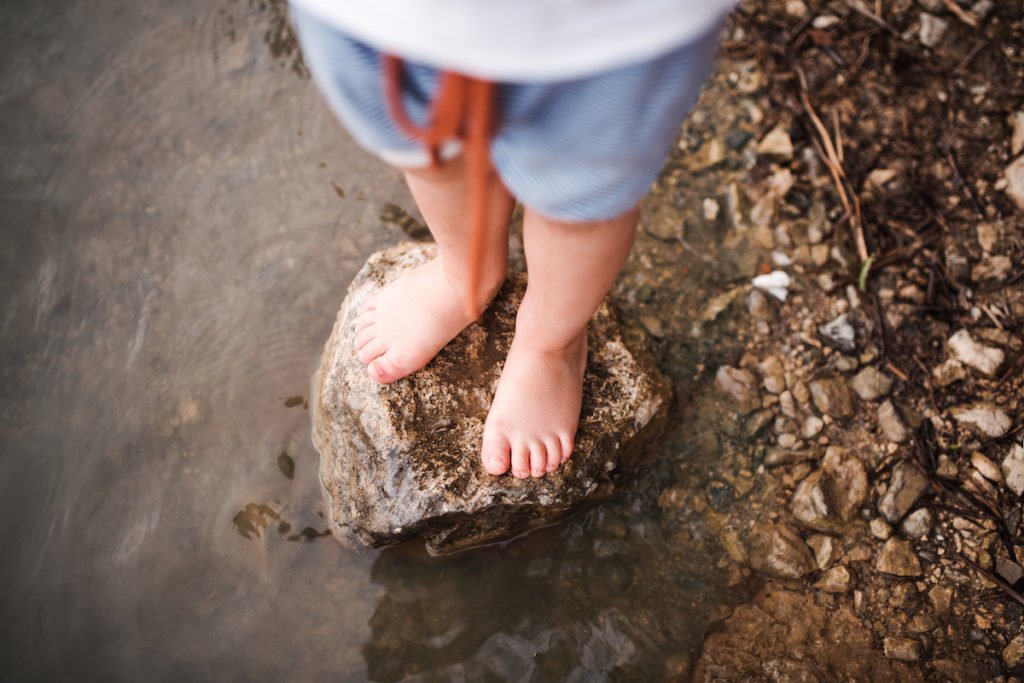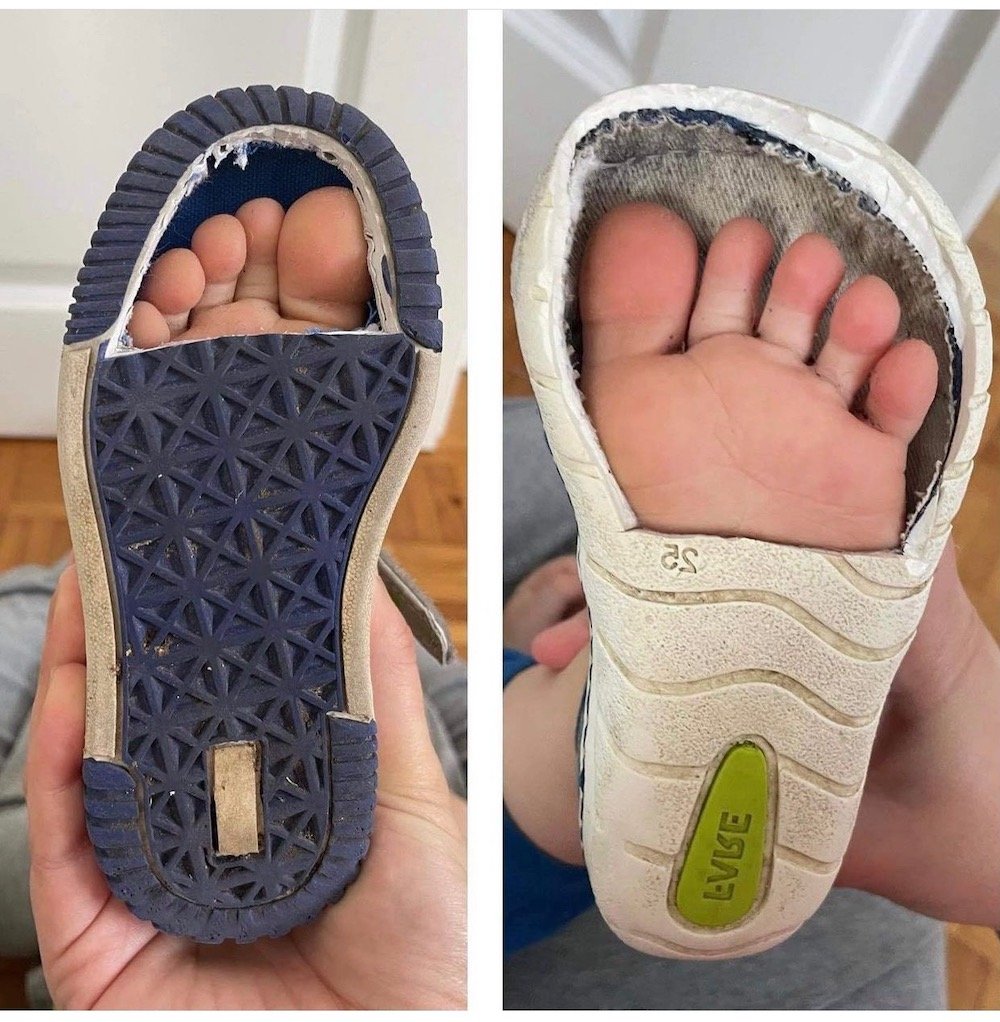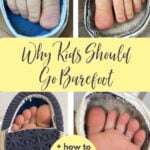Why Kids Should Go Barefoot
Most parents don’t realize that wearing shoes (too often or the wrong types) can lead to what some experts call modern foot binding. Here are the many benefits of going barefoot, especially for the developing feet of babies and kids.

Americans are often shocked to learn about the ancient Chinese tradition of foot binding, or the practice of tightly wrapping young girls’ feet to change their size and shape. Small feet were thought to be a symbol of femininity and social status among Chinese women.
After ages of deformities, pain, and infection, the practice was banned around the turn of the 20th century. The West applauded the end of a barbaric tradition.
What is Modern Foot Binding?
The irony is that although we don’t walk around with literally bound feet, modern shoes have changed the shape and alignment of our feet. And our fascination with narrow high heels and stiff, structured shoes that allow little movement aren’t doing our bodies any favors.
“In essence, we still practice the ancient art of Chinese foot-binding,” explains Jay Dicharry, author of Anatomy for Runners.
After working with a number of African runners who grew up barefoot, Dicharry, came to the conclusion that the feet of modern people were unnaturally narrow and deformed.
“Infants are born with excellent foot alignment,” writes Dicharry. “Soft tissues and bones remodel based on the way they are loaded.”
Of the barefoot runner, Dichary observed, “Years of barefoot movement have resulted in robust muscular attachments to anchor and stabilize the foot. The average Western foot — having grown up dependent on shoes — pales in comparison.” (source)
He notes that the widest part of a newborn’s foot is not the ball of the foot, but their toes. He says of adult feet, “The narrow toe boxes in athletic and fashion footwear have changed the alignment of our feet, just like braces once did to legs.”
Why Are Most Shoes Problematic?
“Typical running shoes are produced for a man weighing 150-plus pounds and a woman weighing 130 pounds,” Dicharry shares. “Many of the same materials are used in the construction of shoes meant for kids who weigh a fraction as much. And the smaller physical size means that all that stitching and those material attachment points net a much stiffer shoe than the adult versions. Kids don’t have the physical weight to flex these shoes.”
This is a problem, because the foot is designed to move at many different points. The big toe is wider for a reason – to provide leverage. These movements help strengthen different muscles, affecting whole body alignment.
The Benefits of Kids Going Barefoot
Going barefoot is important for infants and toddlers who are learning to walk. Podiatrist Tracy Byrne told The Guardian that when toddlers learn to walk barefoot, they experience more stability and fewer falls.
“The feedback they get from the ground means there is less need to look down, which is what puts them off balance and causes them to fall down,” she explains.
Byrne adds that going barefoot is important for muscle development. It strengthens your child’s foot arch, and it helps with posture.
Even More Barefoot Health Benefits
- Proper development occurs when the feet aren’t constricted or bound.
- Walking barefoot outside helps kids connect with nature (which can lead to more positive mental health outcomes).
- Going barefoot strengthens the feet and helps muscles develop better.
- Walking barefoot improves balance.
- Research shows going barefoot may lead to better brain development (more below)
- Walking and climbing barefoot improves proprioception (the body’s ability to sense movement, action, and location).
- Going barefoot gets more blood flowing to the feet and legs.
- Walking barefoot stimulates reflexes on the bottoms of your feet, helping to decrease blood pressure, inflammation, reducing stress and tension, and stimulating other healing processes of the body.
- Researcher Stephen Heppell examines the effects of barefoot learning and shoeless classrooms. His studies show significant improvements in behavior, learning, and classroom dynamics when students AND the teachers are barefoot in the classroom. (source)
And just a bit of common sense advice… be sure to teach your kids how to clean their feet properly after playing outside. Filthy floors or furniture don’t help a child’s development or a parent’s mental health.
How to Choose Shoes That Support Proper Development
This fascinating Instagram post highlights the issue with the average shoe made for kids. They posed the question: why is it that 98% of children are born with healthy feet, but only about 40% of adults still have healthy feet?
They explain that the wrong footwear is to blame. And they removed the soles of two toddler shoes to illustrate their point. The shoe on the left is an example of modern foot binding.

Image via @barfussfreaks on Instagram
“The toe box is one of the most important criteria for barefoot shoes. In an ergonomic toe box, the feet have space and the toes can unfold freely, thus the feet can roll down healthy and the muscles have room to work. Feet are in a stable and secure position. In a tight and narrow toe box running in front, the toes are pressed together. It’s no longer possible to roll off healthy, the muscles can’t work properly.”
“A narrow, inappropriate toe box can also lead to malfunctions and/or deformations of the toes. This can be avoided by paying attention to the proper shape of the toe box and also to ensure that it gives enough space for the feet. The shoe should match approximately the shape of the foot.”
Fellow eco enthusiasts will appreciate that they used old shoes for the experiment because, “It would not be ecological to cut new shoes.”
What to Look for in Barefoot Shoes for Kids
Whether it’s a safety, weather, or hygiene situation, there are times where kids need to wear shoes. Here’s a full article on choosing baby’s first shoes. And here’s what to look for in proper footwear for kids and teens.
Wide Toe Box – As highlighted in the images above, choose a shoe that fits the natural shape of the foot, including plenty of room for the toes. This prevents the likelihood of bound foot issues.
Flexible Soles – The soles of kids’ shoes should provide protection but should follow the shape of the sole of the foot. Flat, thin soles allow your child to still feel changes in the surface below their feet.
Flat – Find shoes with no heels or raised areas. Flat soles allow the same position as no shoes. And it’s really best to avoid high heel shoes for kids.
Our Top Picks for Barefoot Shoes
These are the brands we’ve found to meet the criteria above.
Vivo Barefoot Shoes
Vivo Barefoot is a leader in the barefoot shoe movement, offering a wide range of minimalist footwear that promotes natural foot function. Their shoes feature ultra-thin soles for maximum sensory feedback, flexible construction, and a commitment to sustainability with many models made from recycled materials. Find them in their Amazon store or their website.
Merrell Bare Steps
Designed specifically for little feet, Merrell Bare Steps shoes combine the barefoot philosophy with the support kids need. They feature flexible soles, rounded edges to mimic the shape of a child’s foot, and durable materials that can handle active playtime. Find them at Merrell Bare Steps.
Wilding Shoes
Wilding Shoes stands out with its dedication to sustainability, crafting barefoot shoes from organic, recycled materials like cotton, linen, hemp, and wool. Their lightweight, flexible designs support natural movement while respecting the planet. Find them at Wilding Shoes.
Splay Athletics
Splay Athletics focuses on minimalist shoes that support natural foot development for all ages. With wide toe boxes and flexible soles, their shoes encourage proper toe splay and barefoot-like movement, all while being affordably priced. Find them at Splay Shoes.
Xero Shoes
Xero Shoes are designed to let your feet move naturally, with zero drop soles and flexible, lightweight designs. They’re known for their durability and versatile styles, from casual wear to athletic performance, making them perfect for everything from running to everyday adventure. Find them at Xero Kids, Xero Women and Xero Men.
Flux Footwear
Flux Footwear blends minimalist design with modern style, offering barefoot shoes that don’t compromise on aesthetics. Their shoes provide the benefits of natural foot movement with a sleek look that fits into any wardrobe. Find adult sizes at Flux Footwear.
Peluva
Peluva brings an artistic flair to barefoot footwear, with unique designs that still honor the principles of natural movement. Their shoes are crafted to be flexible and breathable, allowing for freedom of movement while making a fashion statement. Find adult styles at Peluva.
Going barefoot allows children to develop stronger, healthier feet while improving their balance, coordination, and sensory connection to the world around them. By embracing barefoot play, we support their natural growth, encourage mindful movement, and help them build a lifelong foundation for physical and emotional wellbeing.
And this quote from Dr. Wayne Dyer feels like a good way to sum all of this up. “If you walk around in shoes all the time, the whole earth feels like leather.”

